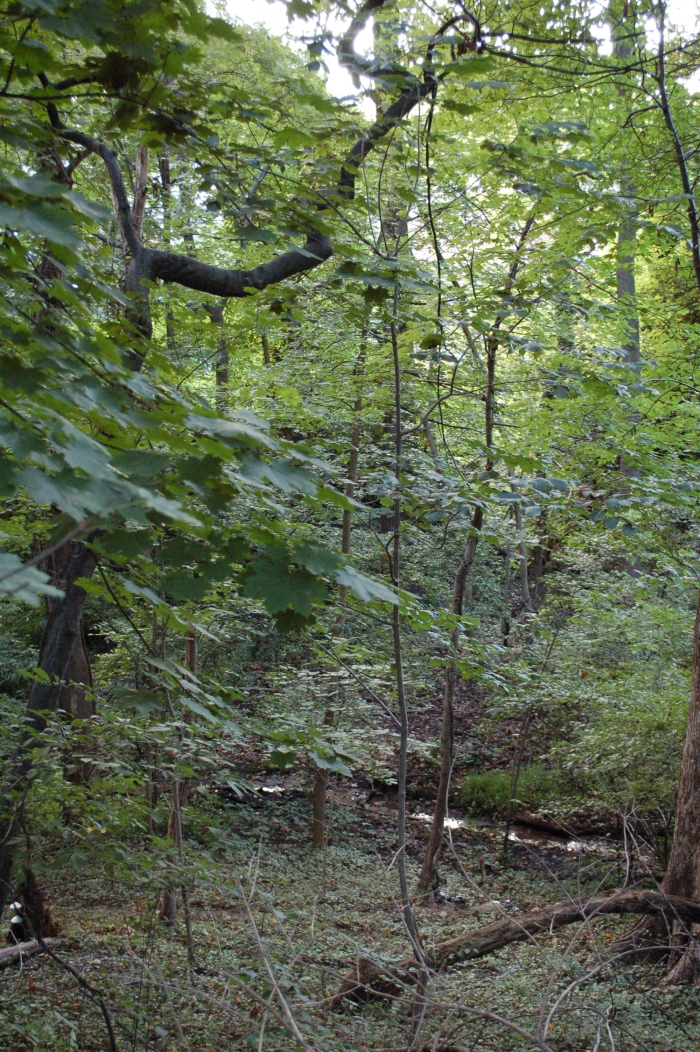Steve Saari and Stephen Reiling want to do what they can to protect the watershed encompassed by Glover Archbold National Park. But.
“Glover Archbold is an extremely complex place,” says Saari, chief of the planning and restoration branch of the D.C. Department of Energy and Environment’s watershed protection division. The flow is “not at all a natural stream flow.”

DC Department of Energy & Environment watershed planning and restoration branch chief Steve Saari, left, focused his undergraduate and master’s degrees education on environmental science and urban ecology. Stephen Reiling, a department environmental engineer, focused his undergraduate and master’s degrees on biological resource engineering and public policy. Photo Credit: John A. Bray
The park takes runoff from all sides along its length, from Van Ness Street on the north end to Canal Road on the south. And much of its centerline harbors a streambed, known as Foundry Branch, and a massive combined storm water and sewer pipe. Oversight of the park involves many city and federal agencies, and public and business interests in how the area is managed are diverse.
Meanwhile, the park erodes. Trees lose their footing. Trails slip away. The forest floor is scoured. And the stability of the utility pipe — cracking and increasingly more exposed in places and intruded by roots — is being undermined.

BATTERED SEWER ACCESS: Debris piles up in the streambed of Glover Archbold National Park, just north of Reservoir Road in northwest Washington, D.C. Photo Credit: John A. Bray
Reiling, an environmental engineer in the division, said there are restoration options. “We can use different natural structures and features to slow that storm water down and dissipate the energy so it’s not tearing up the stream like it currently is.”

Advertisement
Such efforts might include creation of step pools along the stream path.
But when could such work be done? The utility pipe, which is nearly 100 years old, is the focus of a DC Water and Sewer Authority rehabilitation project that remains on the drawing board. The authority, which says the pipe system is at the end of its “maximum expected lifespan,” closed a public comment period on the scope of the project in October 2013, and expects to submit a draft environmental assessment by the fall of 2016 and hold additional public meetings in late 2016.
“We can’t go in and do any kind of restoration if there is sewer work to be done,” Reiling said. “We don’t want to impact the park more than once.”

TRAIL SLIPPAGE: The pathway ground covering atop the combined storm water-sewer pipe that runs in the middle of the park fades with erosion. Photo Credit: John A. Bray
Environmental strategies also include releasing piped streams back to the surface. The practice, called daylighting, creates wildlife habitat and improves water quality through exposure to soil and sunlight, Saari said during our interview at the agency’s offices at First Street NE in NOMA.
“Right underneath us is Tiber Creek. It used to empty into the Potomac by the Jefferson Memorial,” Saari said. “The stream is gone. There are a lot of streams that have been piped for one reason or another.” Those reasons include establishing land to support building construction.

STREAM LIBERATION: The thread of a creek that was released from pipe confinement is visible in the woods behind the Politics & Prose bookstore on Connecticut Avenue near Nebraska Avenue. The “daylighting” project involved about 1,600 feet of piping, according to DC watershed restoration officials. Photo Credit: John A. Bray
With the amount of storm water now going into Glover Archbold, daylighting does not look feasible to Reiling.
“To take Foundry Branch out of the pipe and reintroduce it to the surface, the volume would just be way to great,” Reiling said. “Conditions are different in the city than they were 200 years ago.”
Saari doesn’t foresee city storm water runoff volume getting worse.
He anchors his optimism in the city’s 2013 regulations, which, for example, require developers disturbing more than 5,000 square feet of land to keep substantial amounts of storm water on site. For example, landscaping can be created to absorb storm water and it can be impounded for use in flushing toilets.
The regulations requires retention of the first 1.2 inches of rain that falls during a 24-hour period, a standard that covers 90 percent of rainfall events for the city, according to Saari and Reiling. Reducing the runoff also serves to limit the “first flush” of accumulated surface pollutants that ordinarily would wash into the watershed.
“The idea previously was to get storm water off site as quickly as possible,” said Saari. While steps were taken to reduce pollutants, little or nothing was done about the volume of water — the torrents that erode terrain, and wash away buildings and belongings.

After a heavy rain, storm water runoff piles up on the north side of the earthwork that carries Reservoir Road across the park. DC watershed protection officials say the setting might be conducive to landscape redesign as a formal wetland habitat. Photo Credit: John A. Bray
Regulators are seeking reductions across the board, including with individual homeowners. For residential properties and communities, including universities, agency programs include providing education and financial subsidies for storm water retention measures, such as installation of rain barrels and replacing impervious surfaces with plantings.
“As we move forward, our streams are getting better,” Saari said.

WOODS WEB: A Glover Archbold National Park spider attends to its threads. Photo Credit: John A. Bray
© 2016 John A. Bray

Advertisement


